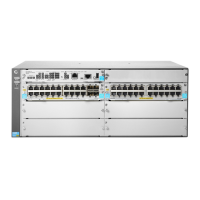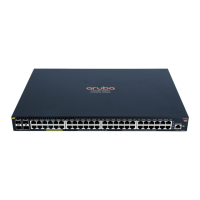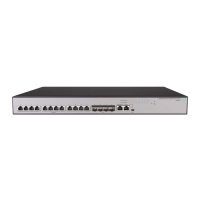36
{ The port does not receive LACPDUs from its peer port.
Operational key
When aggregating ports, the system automatically assigns each port an operational key based on
port information, such as port rate and duplex mode. Any change to this information triggers a
recalculation of the operational key.
In an aggregation group, all Selected ports are assigned the same operational key.
Configuration types
Every configuration setting on a port might affect its aggregation state. Port configurations include
the following types:
• Attribute configurations—To become a Selected port, a member port must have the same
attribute configurations as the aggregate interface. Table 1 de
scribes the attribute
configurations.
Attribute configurations made on an aggregate interface are automatically synchronized to all
member ports. These configurations are retained on the member ports even after the aggregate
interface is removed.
Any attribute configuration change on a member port might affect the aggregation states and
running services of the member ports. The system displays a warning message every time you
try to change an attribute configuration setting on a member port.
Table 1 Attribute configurations
Feature Considerations
Port isolation
Indicates whether the port has joined an isolation group, and which isolation
group the port belongs to.
QinQ
QinQ enable state (enabled/disabled), TPID for VLAN tags, and VLAN
transparent transmission. For information about QinQ, see "Configuring QinQ."
VLAN mapping
Different types of VLAN mapping configured on the port. For more information
about VLAN mapping, see "Configuring VLAN mapping."
VLAN
VLAN attribute configurations include the following:
• Permitted VLAN IDs.
• PVID.
• Link type (trunk, hybrid, or access).
• Operating mode (promiscuous, trunk promiscuous, host).
• VLAN tagging mode.
For information about VLAN, see "Configuring VLANs."
• Protocol configurations—Protocol configurations do not affect the aggregation state of the
member ports. MAC address learning and spanning tree settings are examples of protocol
configurations.
NOTE:
The protocol configuration for a member port is effective only when the member port leaves the
aggregation group.
Link aggregation modes
Link aggregation has dynamic and static modes:

